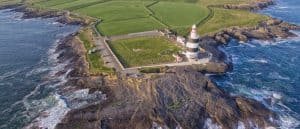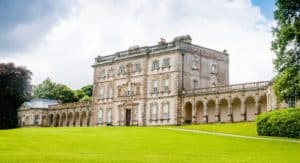Beyond the Leprechaun: Exploring the Lesser-known Irish Mythology

Updated On: April 24, 2024 by Raghda Elsabbagh
When we think of Irish mythology, the image of the cheeky Leprechaun is often the first to spring to mind, with tales of hidden pots of gold and trickery. However, Ireland’s folklore is a rich tapestry woven with numerous lesser-known Irish myths and legends just waiting to be rediscovered. Steeped in centuries of history and culture, Irish mythology offers a window into the soul of Irish heritage, illustrating the beliefs, traditions, and values deeply embedded within the national identity.
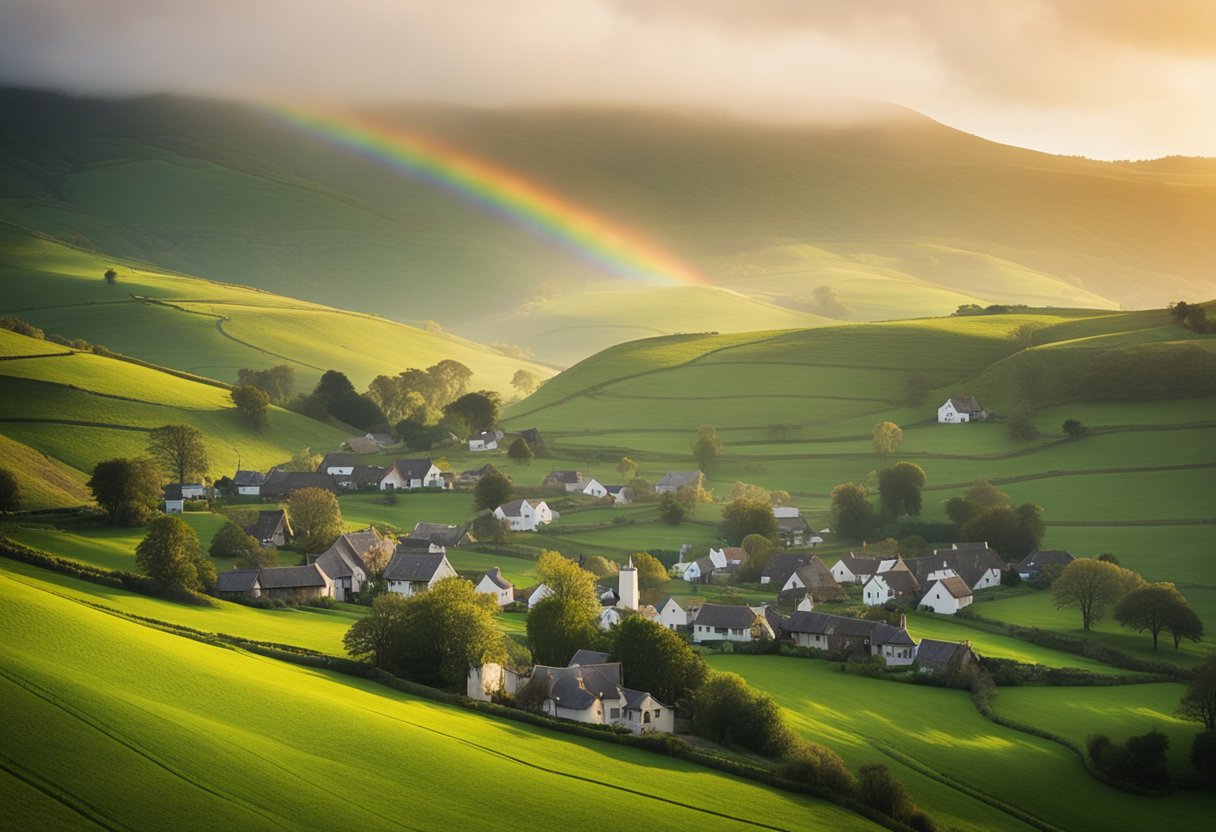
Our journey through Irish mythology reveals a world beyond the familiar Leprechaun, where ancient heroes, gods, and fantastical creatures reside. From the Tuatha Dé Danann, the famed pantheon of Celtic deities, to the epic sagas of the Fenian and Ulster Cycles, these tales are intrinsic to Ireland’s cultural fabric. The narratives not only serve as an embodiment of Irish storytelling but also provide fascinating insights into how myth and history intertwine on the emerald isles, influencing Ireland’s landscapes and traditions that endure to this day.
Table of Contents
The Origins of Irish Mythology
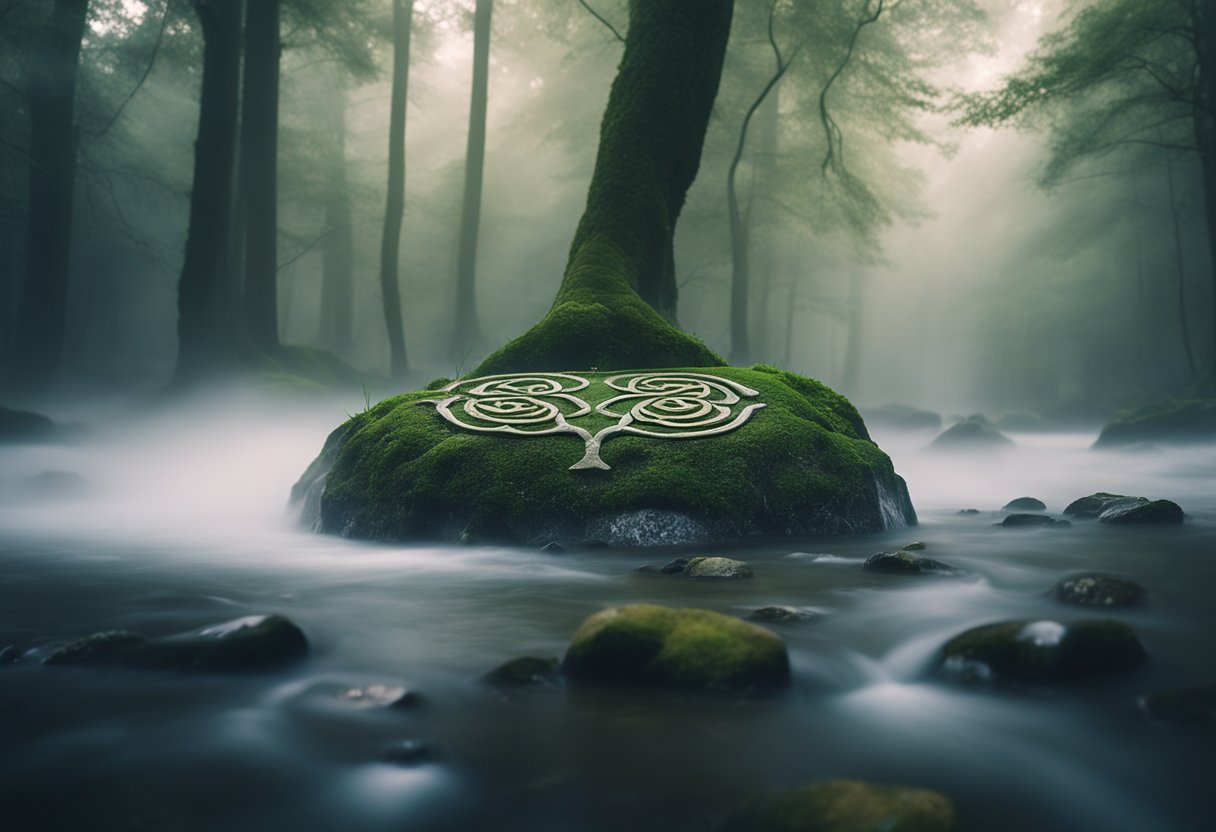
Before delving into the rich tapestry of Irish mythology, it’s crucial to understand its roots. The mythological framework of Ireland is built upon a series of invasions and the pantheon of deities that shaped the land and its lore.
The Mythic Invasions
Irish mythology chronicles several waves of invasions by different peoples, each bringing their own customs and gods into Ireland. Central to these sagas are the Tuatha Dé Danann, a race of god-like beings whose name translates to “the folk of the goddess Danu.” They are credited with bringing high culture and Druidic knowledge to Ireland but were eventually driven into the shadows by the Milesians, ancestors of modern Irish people. Preceding the Tuatha Dé Danann were the Fir Bolg, known for their farming skills and as the creators of the four cities from which the four treasures of the Tuatha Dé Danann originated.
Ancient Gods and Goddesses
The Irish pantheon is populated with deities representing various aspects of life and nature. Prominently, Danu, the namesake of the Tuatha Dé Danann, signifies the mother goddess archetype, often linked to fertility and prosperity. This pantheon also includes well-known figures such as the Dagda, the good god with mastery over life and death, and Lugh, the multi-skilled god of the sun. These gods and goddesses of ancient Ireland were not seen as omnipotent but rather bound to the forces of nature, wielding power and influence over their domains. Their stories are interwoven with the land, reflecting the change of seasons, celestial events, and natural phenomena, deeply engrained in the tapestry of Irish folklore and mythology.
The Fenian and Ulster Cycles
The Fenian and Ulster Cycles are treasure troves of Irish mythology, offering stories of epic heroes, their quests, and legendary battles that have captivated audiences for centuries. These ancient narratives not only uncover Ireland’s mythological past but also provide insight into the values and beliefs of the society from which they originate.
Epic Tales of Heroes
Fenian Cycle: Known also as the Fiannaíocht, the Fenian Cycle celebrates the legendary Fionn mac Cumhaill, a mythic hunter-warrior endowed with both martial and poetic prowess. One tale that stands out is his encounter with the magical Salmon of Knowledge, from which he gains all the world’s wisdom by simply tasting it. The stories within this cycle depict the Fianna, an elite group of warriors led by Fionn, renowned for their bravery and honour.
Ulster Cycle: The Ulster Cycle, or Rúraíocht, relates the heroic deeds within the kingdom of Ulster, most notably in the epic Táin Bó Cúailnge (‘The Cattle Raid of Cooley’). In this saga, the formidable Cú Chulainn stands alone against the armies of Queen Medb, defending Ulster with supernatural martial abilities. His battle feats and tragic fate form the cycle’s core, embodying the archetypal hero’s path and the inevitable linkage of glory and doom.
Legendary Battles and Quests
The narratives of both cycles are replete with stirring portrayals of battle and quests. Central to the Fenian Cycle are the exploits and adventures that test the mettle of Fionn and his warriors, weaving not only martial encounters but also trials of wit and spirit. Similarly, the Ulster Cycle hosts a series of conflicts and voyages revealing the complex interplay of king, queen, and hero, exposing the ideals and trials of heroism and sovereignty.
Through these ancient mythic cycles, we gain an intricate view of a world where the power of the spoken word was as respected as skill in combat. Heroes like Fionn mac Cumhaill and Cú Chulainn epitomise the cultural and ethical standards of their time as they navigate a landscape dense with enchantment, danger, and the ever-present allure of legacy.
The Pantheon of Celtic Deities
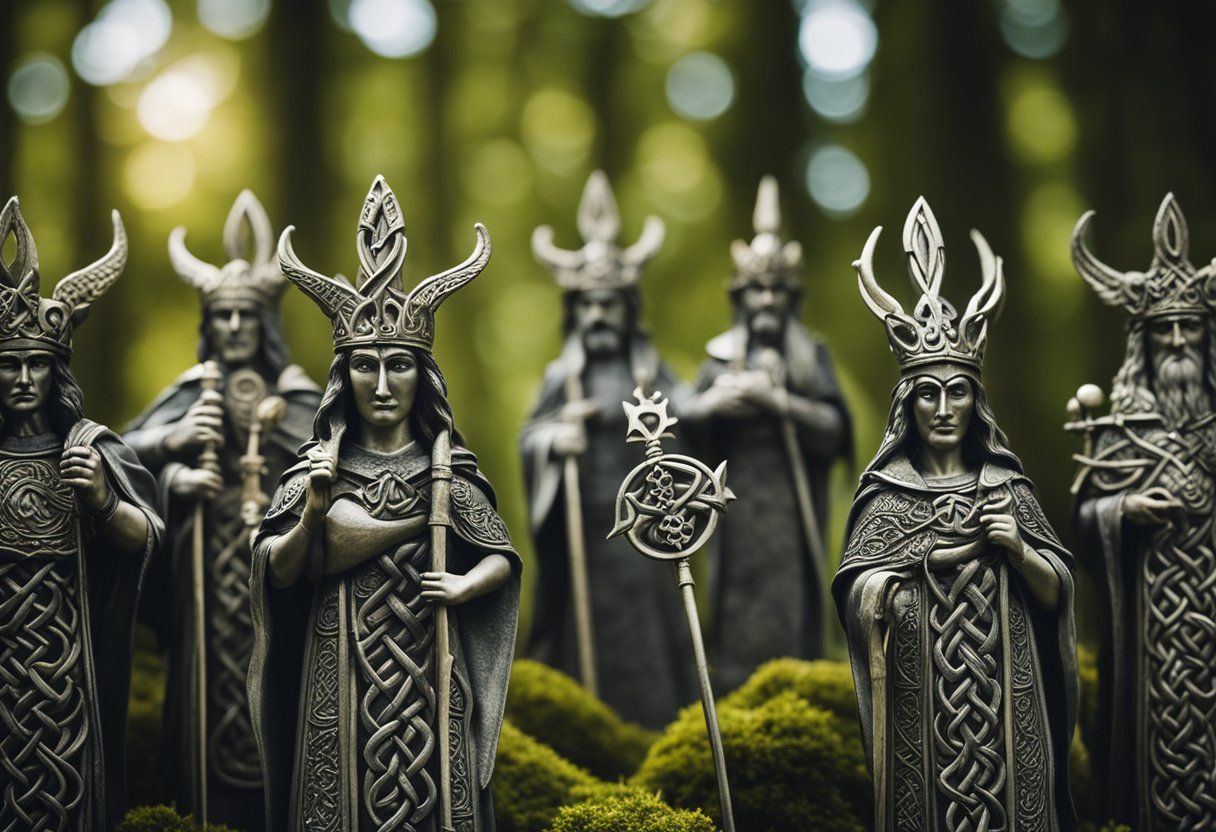
The ancient Celts worshipped a pantheon of gods and goddesses, each with their own distinct realms of influence ranging from war to craftsmanship and from fertility to nature. Their mythology is rich with tales of these deities, who played vital roles in the natural and cultural world.
Gods of War and Craft
The Dagda, often considered the father of the Celtic pantheon, was revered not just for his role in war but also for his mastery over craft. Known as the ‘Good God’, his skills and powers extended beyond battle, symbolising a harmonious blend of strength and artisanship. Within the same martial scope lies the Morrigan, a goddess associated with war and fate whose manifestations reflect the multifaceted nature of battle and sovereignty.
Navigating through the essence of craftsmanship, Aengus, the god of love, youth, and poetic inspiration, stands out. He is also known for his association with the sun, conveying his significance as a life-giving figure in Celtic lore. These deities exhibit a powerful duality—a control over chaos and the celebration of creativity.
Goddesses of Nature and Fertility
Within the verdant realms of the earth, Celtic goddesses command the cycles of life, embodying aspects of nature and fertility. These deities shape the environment, from the forests to the wildlife, echoing the Celts’ deep connection to the landscape. Among them is a goddess of war who also embodies the prosperity that follows peace, associating her with regeneration and the land’s bounties.
A key figure in this respect is the daughter of the Dagda, Brigid, revered as a triple goddess of healing, smithing, and poetry, her influence spanning widely across aspects of nurturing and growth. As a goddess associated with the arrival of spring and fertility, Brigid exemplifies the interweaving of the physical and spiritual growth that marks Celtic belief.
In our exploration of these ancient figures, we uncover a world where divinity intimately interlaces with the daily lives and natural phenomena of the ancient Celts. We gain insight into the complex spirituality that guided and enriched Celtic culture through the reverence of both formidable gods of war and skill and nurturing goddesses of nature and fertility.
Irish Fairy Lore and the Otherworld
Before delving into the realm of Irish myth, it is vital to understand that the Otherworld in Irish lore is an ethereal plane of existence, closely entwined with the land of mortals. Here reside the Aos Sí, or the ‘people of the mounds’, commonly known as fairies, and a host of other supernatural beings.
Enchanting Fairies and Creatures
In the tapestry of Irish mythology, fairies and other enchanted creatures are pivotal figures. The Sidhe, also called the fairies, are considered the most powerful and significant of these beings. Often depicted as stunningly beautiful and eternally youthful, the Sidhe guardians are viewed with both reverence and trepidation. They are closely associated with the Otherworld and are known to interact with humans, for better or for worse.
Among these fairies are the Púca, shape-shifting creatures that can bring either fortune or doom. With her mournful wail, the Banshee is foretold to lament a family member’s death. The Merrow, or mermaids and mermen, are sea fairies that harmonise with the coastal regions of Ireland, influencing the seas. Meanwhile, the Dullahan, a headless rider on a black horse, is said to be a harbinger of death. The famous leprechauns, cobblers to the fairy folk, are known for their mischief and hidden pots of gold.
Portals to the Otherworld
The Otherworld is not just a physical location but a parallel plane that coexists with our world. Portals to this realm are often believed to be natural features such as hills, mounds, forests, or bodies of water. The Hill of Tara, for instance, is acclaimed as a gateway to the Otherworld. The Irish Sea and bodies of water like Lough Gur are also spoken of as entrances to this mystical plane where the Merrow reside.
Such passages to the Otherworld may be revealed during significant times of the year, particularly during Samhain, when the veil between worlds is thinnest. These liminal times are fraught with both peril and promise, as they allow humans and the Aos Sí to cross paths more easily, enabling magical occurrences and exchanges to take place.
Legendary Beasts and Monsters
Irish mythology is teeming with enigmatic entities that go far beyond the widely known leprechauns. From the mighty Fomorians who terrorised both land and sea to the shapeshifting Pookas and the bloodthirsty Dearg Due, these tales weave a tapestry of adventure and caution ingrained in Ireland’s cultural fabric.
Terrors of the Sea and Land
The Fomorians, a race of malevolent giants, ruled the waves and the land with formidable strength. In contrast, the merrows or mermaids, with their enchanting beauty, were believed to inhabit the seas around Ireland. Yet, one must not overlook the Abhartach, often referred to as the ‘Irish vampire’, who instilled fear into the hearts of those who crossed his accursed path. These mythological creatures hold a significant place in the chronicles of Irish folklore, representing the perils that may lurk in the shadows of the natural world.
Shape-shifters and Phantom Riders
Within Irish myths, certain entities were not bound to a single form. The Pooka, a mischievous spirit, took various shapes to interact with mortals, often leaving chaos in its wake. Meanwhile, the Dearg Due was reported to transform from a stunning beauty to a deadly creature driven by a thirst for blood, demonstrating the fluid nature of identity in these stories. Another elusive figure is the Clurichaun, an often inebriated cousin of the leprechaun known to guard wine cellars. These shape-shifters and spectral entities play at the edges of our reality, reminding us of the thin veil that separates the mundane from the magical.
The Interweaving of Mythology and History
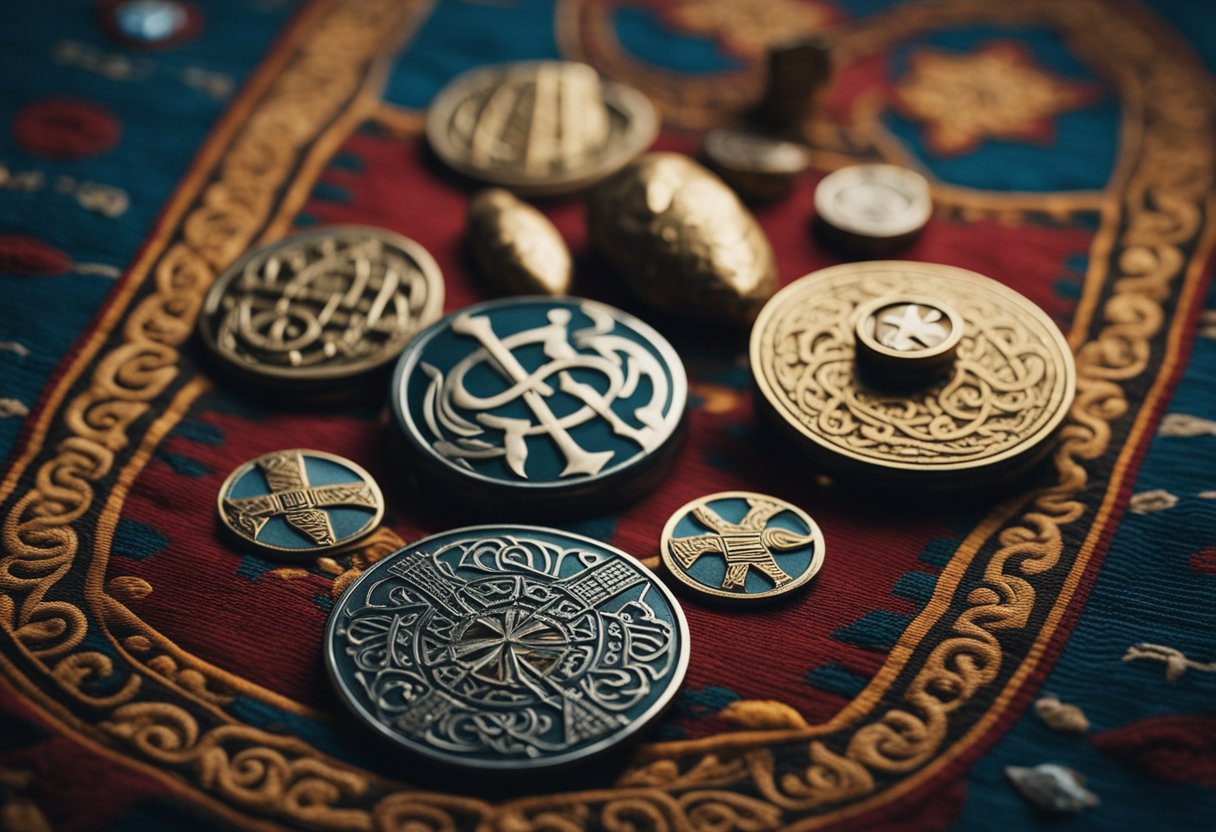
Irish mythology and history are profoundly interconnected, reflecting how the ancient Irish understood their world and recorded their experiences. This complex tapestry offers insights into the evolution of Ireland’s past and the role myths played in shaping cultural identity.
Christianity’s Influence on Myth
The introduction of Christianity to Ireland was a pivotal moment that saw the fusion of Celtic myths with new religious beliefs. Figures like St Patrick, known for converting the Irish to Christianity, became legendary, merging with the mythological narrative. As Christian scribes recorded the country’s history, they altered or reinterpreted pagan myths, ensuring that these ancient stories aligned with Christian values and teachings.
The Historical Basis of Myths
Irish myths often contain kernels of historical truth embedded within their fantastical elements. High kings and great battles, for example, are recurrent themes, likely inspired by real events and leaders of the Iron Age. Giant’s Causeway is a natural wonder steeped in myth, yet it also serves as a testament to Ireland’s geological history. Consequently, these stories can serve as a window into the past, offering glimpses of Ireland’s culture and the experiences of its people through the ages.
Immortal Love Stories and Tragedies
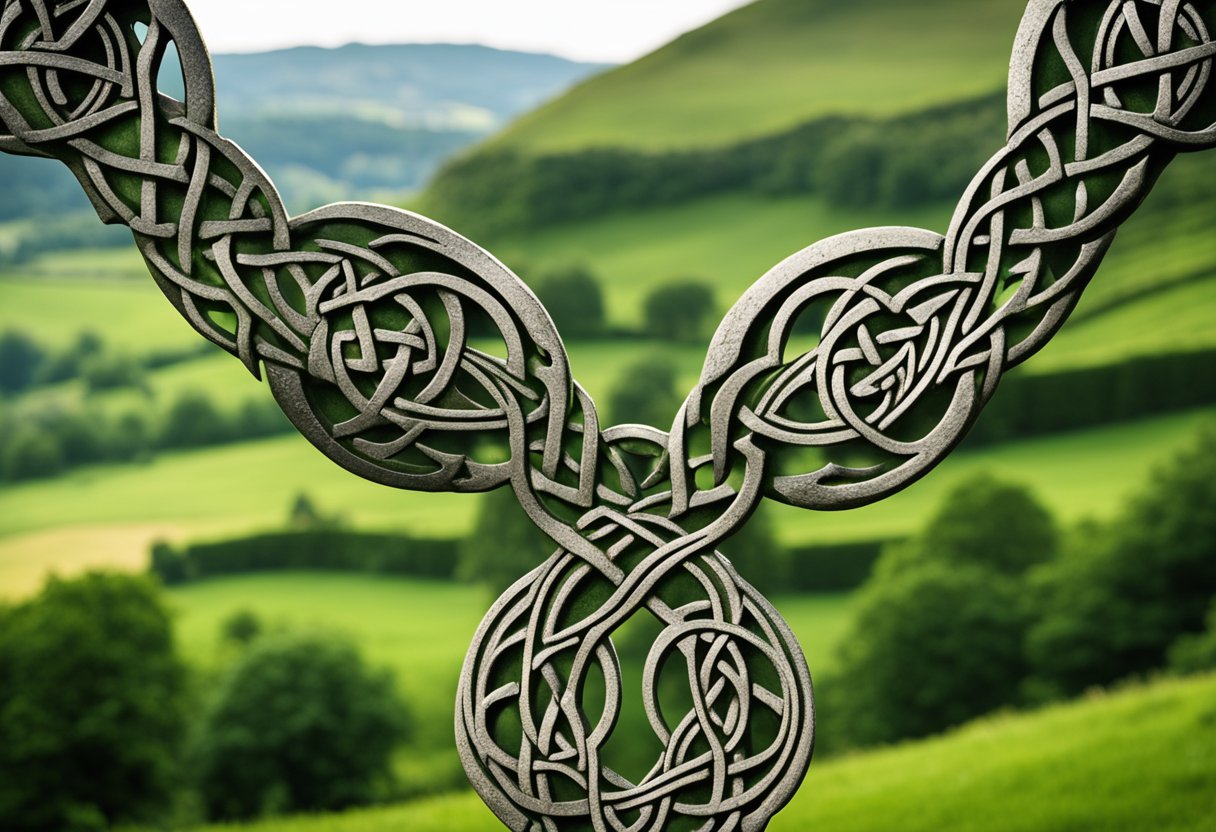
Within Irish mythology, tales of love and loss are profound and poignant, carrying both the sweetness of affection and the bitter permanence of sorrow. The narratives often delve into themes of undying love and the inescapable tragedies of the mortal realm.
Cursed Love and Unending Sorrow
The Children of Lir is a tale imbued with deep love and the harshness of cruel fate. Lir’s beloved children, transformed into swans by a wicked stepmother’s spell, embody both the innocence of love and pure filial devotion. For 900 years, they were condemned to live as creatures of the lakes and seas, only their haunting melodies expressing the depths of their sorrow. This legend illustrates the intertwined nature of love and grief, where the wails of the swans are as heartrending as those of the famed banshees, whose lament foretells death.
Eternal Youth and Tragic Fates
In another tale, eternal youth is shadowed by foretold doom. Oisín, a famed hero and a member of the Fianna, fell deeply in love with Niamh, a maiden from Tír na nÓg, which is known as the land of youth and beauty. This legendary coupling straddled the worlds of mortality and the ever-lasting, promising Oisín a life free from ageing. But when he returned to Ireland, the tragedy of time passed became apparent. Oisín’s life speaks to the ephemeral nature of youth and the inevitability of fate, which not even divine love could avert.
The cycles of Irish mythology showcase the perpetual dance of joy and despair, where the heights of love often precede the depths of tragedy. These stories, etched into the cultural fabric, continue to remind us of the complex tapestries woven by desire and destiny.
From Myth to Symbolism in Modern Culture

We see a rich vein of Irish mythology threading through the fabric of modern culture, transforming age-old myths into contemporary symbolism and mediums.
Celtic Symbolism
The lore of ancient Ireland is steeped in symbols that go beyond mere decoration, embodying deep meanings and beliefs. The Ogham alphabet, for instance, is more than a series of marks; it represents a sacred script that was attributed to trees and nature and had profound importance in storytelling and preserving knowledge. This cryptic alphabet has found new life in various facets of art and design, paying homage to the mystique of Celtic heritage.
- Irish Mythology in Modern Design:
- Ogham jewellery: Celebrates Irish heritage with cryptic messages
- Celtic knots: Featured in tattoos and artwork, symbolising eternity
Lesser-known Irish Myths in Contemporary Media
Contemporary media have embraced Irish myths, weaving these rich tales into the narrative fabric of films, books, and television. Compelling Irish folklore has not only survived but thrived, resonating with global audiences and ensuring the continuation of storytelling traditions.
- Film and Literature:
- Modern interpretations of Irish myths refresh ancient tales
- Characters rooted in folklore become relatable protagonists
We witness a renewed interest in elements like the leprechaun but also in the lesser-known corners of the mythos, such as the banshee or the Tuatha Dé Danann, reimagined in ways that reflect current values while honouring their origins. The conversation between past and present is ongoing, a testament to the enduring power of Irish culture in informing and enriching our contemporary world.
The Living Tradition of Storytelling
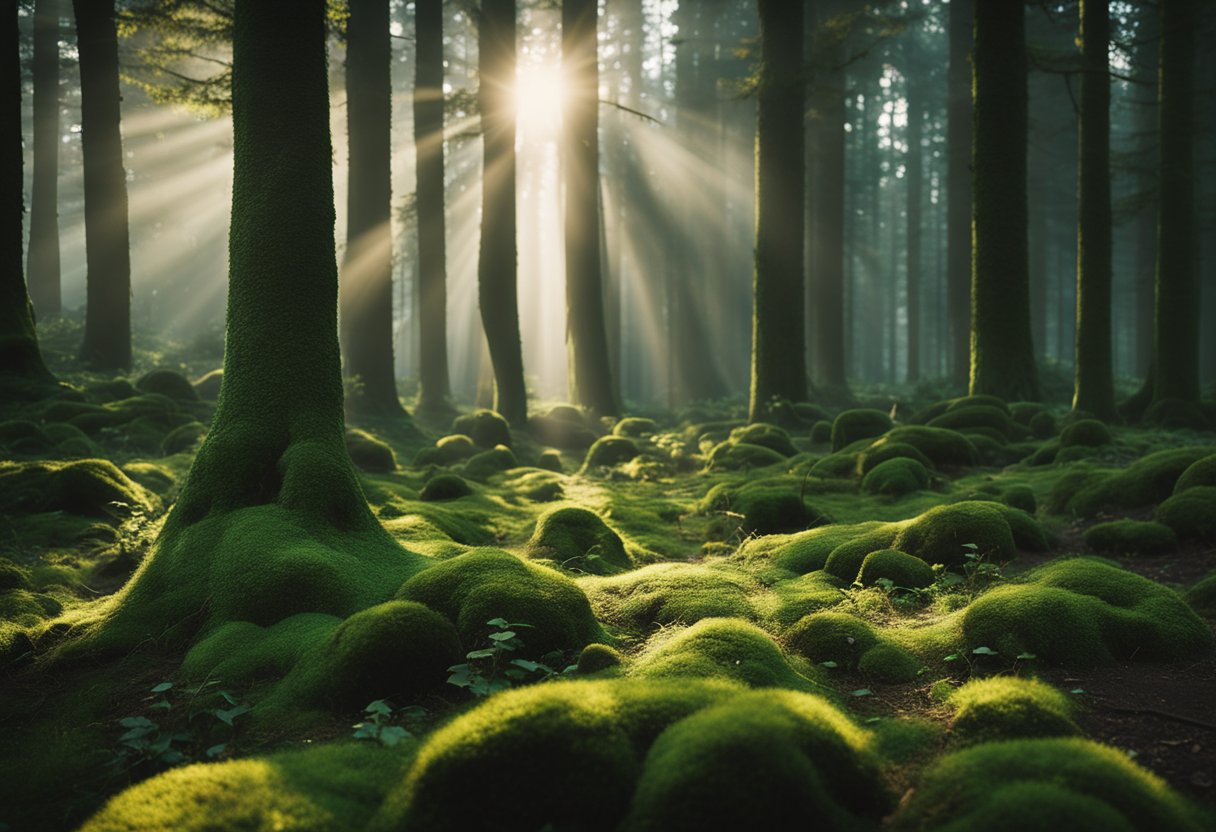
In Ireland, the art of storytelling is a celebrated tradition, where oral histories and myths play a pivotal role in preserving the nation’s culture and heritage, especially in its rural heartlands.
Preservation of Oral Histories
We understand the importance of storytelling as a means to preserve and transmit Ireland’s rich history and traditions. In rural Ireland, stories are an integral part of community life, with oral narratives binding generations through the sharing of folk tales and local lore. Often filled with elements of the supernatural, these tales provide insights into the cultural psyche and values.
Festivals and Seasonal Celebrations
Ireland’s calendar is dotted with festivals and seasonal celebrations that are steeped in storytelling. Notably, Halloween, with origins in the ancient Celtic festival of Samhain, is a time when storytelling takes centre stage, bringing to life tales of ghouls and spirits. During the summer months, traditional gatherings such as the Puck Fair and the Lisdoonvarna Matchmaking Festival become vibrant hubs where storytelling complements the revelry, ensuring that the tradition remains not just alive but also a thriving aspect of holiday festivities.
Irish Mythology in the Landscape
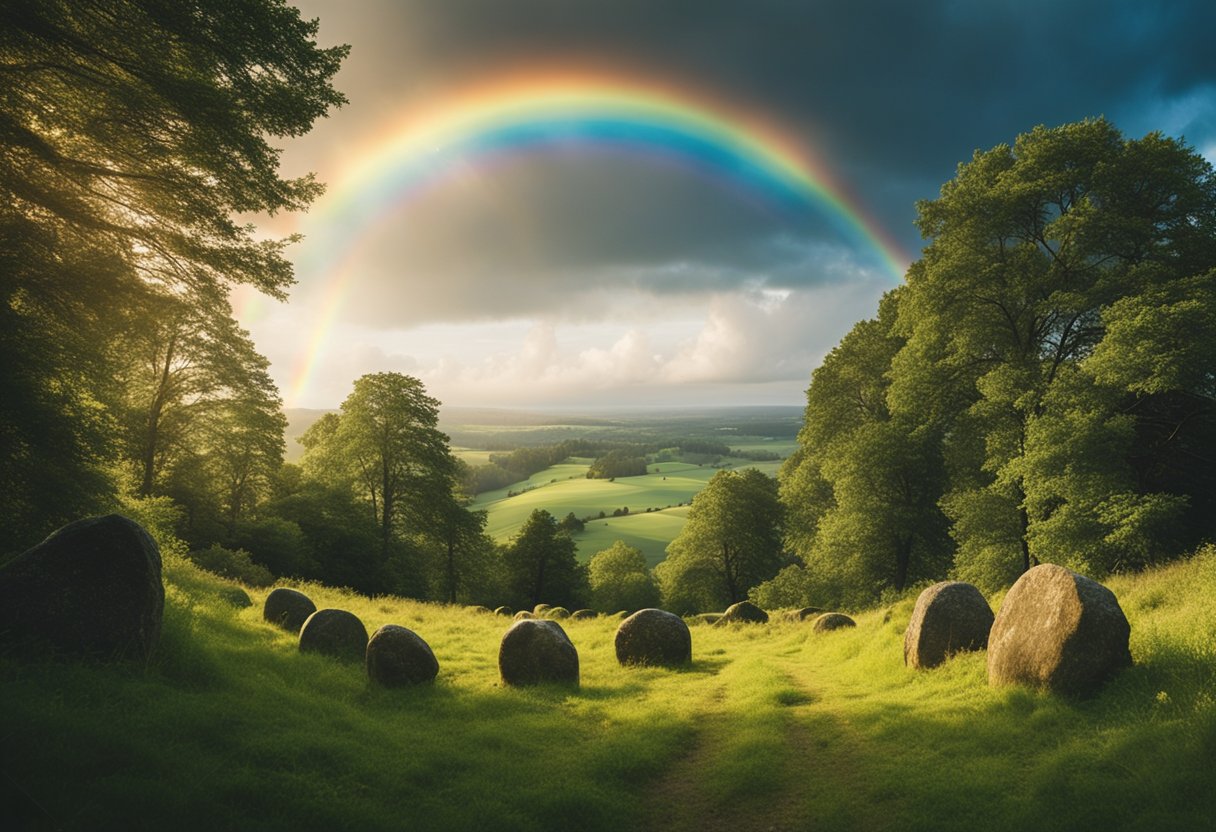
The tales of Irish mythology are intricately woven into the fabric of Ireland’s countryside. In the emerald expanses and rugged outcrops, legends spring to life, beckoning us to explore beyond the familiar tales of leprechauns. We encounter landmarks steeped in ancient myths, where the landscapes themselves are characters in Ireland’s storied heritage.
The Giant’s Causeway is a prime example, where basalt columns are reputed to be the remnants of a bridge built by the giant Fionn mac Cumhaill. The interlocking stones seem almost supernatural, inviting us to ponder the feats of giants from Ireland’s mythic past.
| Location | Mythological Significance |
|---|---|
| Giant’s Causeway | Said to be the work of giant Fionn mac Cumhaill |
| Cooley Peninsula | Site of the epic Cattle Raid of Cooley |
In rural Ireland, the lushness of nature and rustic landscapes are the very scenes where heroes and entities of lore roamed. Cú Chulainn, the great hero of the Ulster Cycle, defended the province of Ulster in the Cattle Raid of Cooley, a tale resonating within the rolling hills where it is imagined the great herds once grazed.
Horses, ever-present in Irish tales, carry heroes through perilous adventures. The embodiment of nobility, grace, and strength is as much a part of Ireland’s heritage as the legends themselves.
As we traverse this ancient land, Irish culture emerges from the very earth, stones, and waterways that shaped these stories. It’s a reminder that the mythos of a place intertwine with its physical presence, captivating our imagination and preserving the soul of Ireland’s folklore. Here, every hill, every glen holds a story, a whisper of the mythic past ready to be uncovered by those who seek it.
Frequently Asked Questions
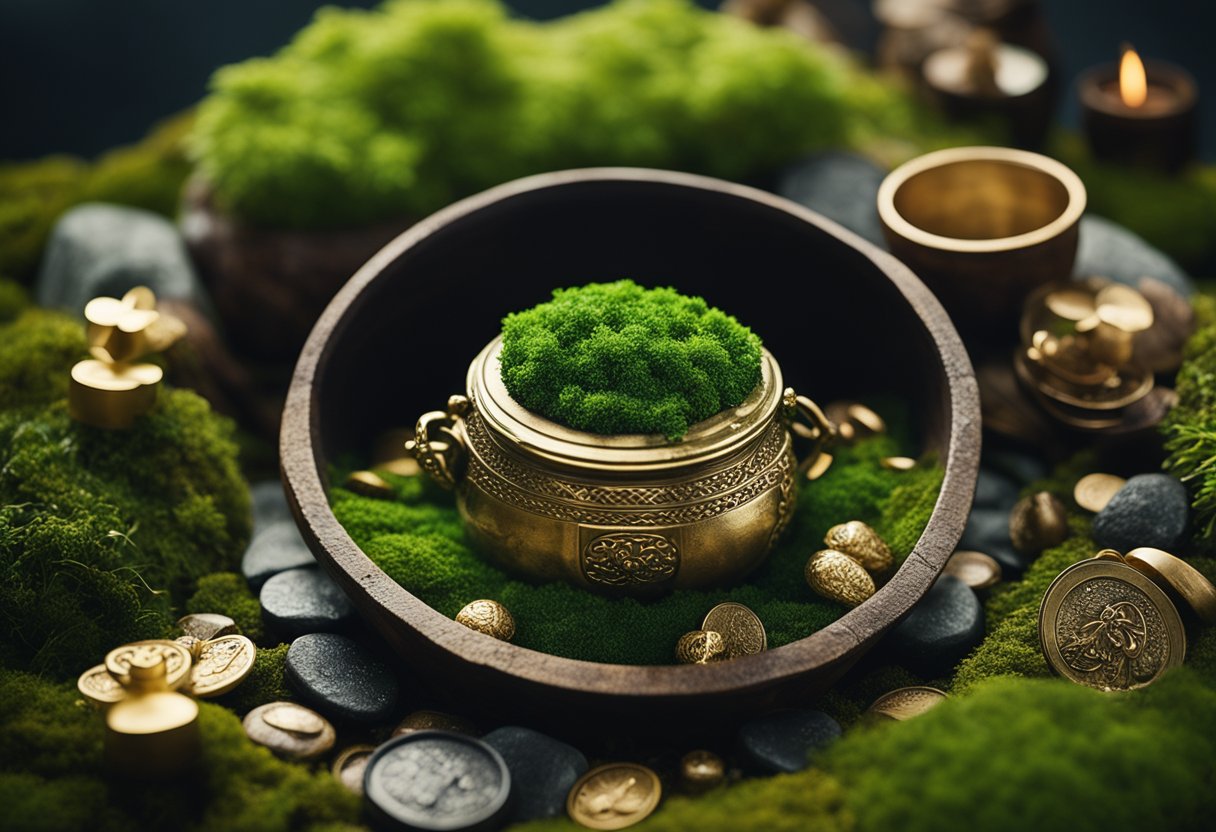
In this section, we’ll address some common queries regarding the enchanting yet often overlooked aspects of Irish mythology.
Who are the prominent figures in Irish folklore?
Apart from the renowned leprechauns, there are many influential characters in Irish folklore. Cú Chulainn, the hero of the Ulster Cycle, is famed for his supernatural strength and martial prowess. Another key figure is Fionn mac Cumhaill, leader of the Fianna warriors, known for his wisdom and bravery.
Can you name some feared creatures from Irish mythology?
Irish mythology harbours a variety of formidable creatures. The Dullahan is one such creature, a headless rider on a black horse who carries his head under his arm. The fearsome Morrígan, a goddess of war, often took the form of a crow and was associated with doom and death on the battlefield.
Which stories are considered classics within Celtic mythology?
The stories of the Tuatha Dé Danann, the divine tribe who are said to have ruled Ireland before the human Celts, are intrinsic to Celtic mythology. Tales from the Ulster Cycle and the Fenian Cycle are also considered classics, telling the adventures of Cú Chulainn, the Knights of the Red Branch, and the Fianna.
What distinguishes the Banshee from other mythological beings?
The Banshee is unique for her mournful wail that foretells the death of a family member. She is often depicted as a woman in white with long, flowing hair and is considered to be a messenger from the Otherworld, warning of imminent passing rather than causing it.
What are some notable female entities in Irish myth?
Among notable female entities, the sovereignty goddess Ériu represents the land of Ireland itself, and her name is the origin of the modern name Éire. Another is Brigid, who embodies healing, spring, and dawn and is celebrated in the festival of Imbolc.
Which Irish myth predates the rest in terms of historical records?
The Lebor Gabála Érenn or ‘Book of Invasions’ is a collection of poems and prose that recounts the mythological history of Ireland, from its creation to the arrival of the Celts. It is one of the earliest sources, weaving together mythic and historical strands to chart the succession of peoples in Ireland.


